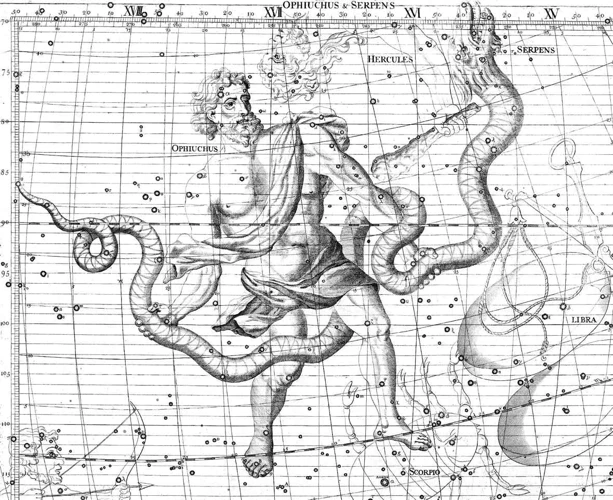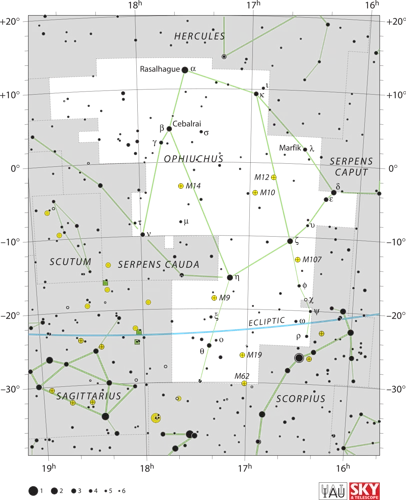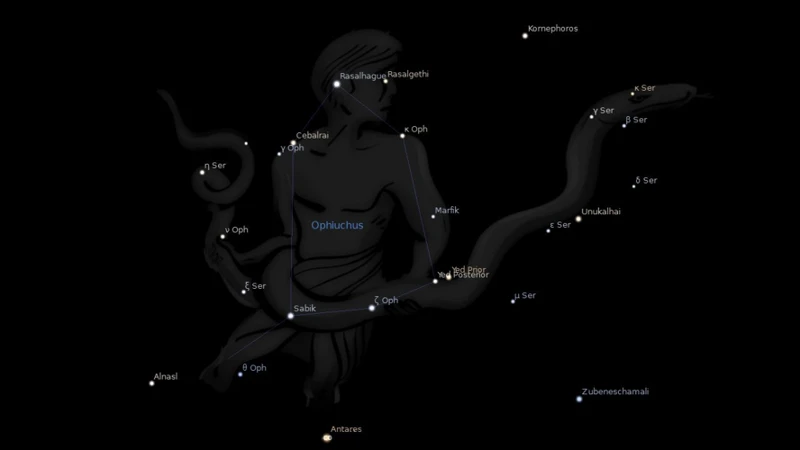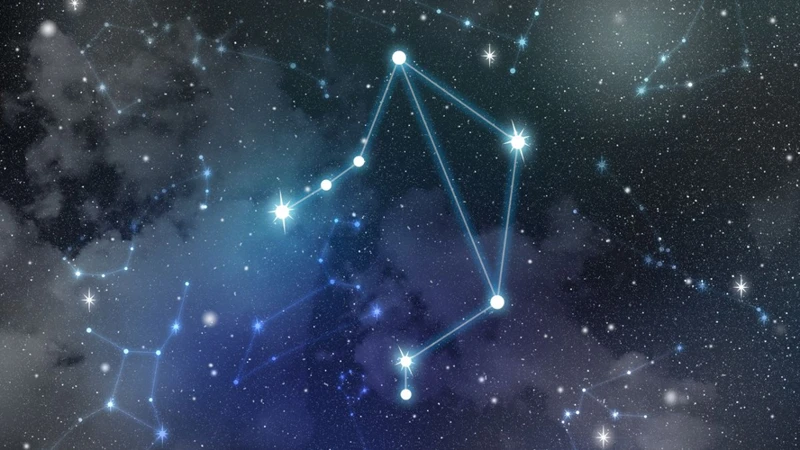In the vast realm of ancient mythology, there lies a duo whose intertwined story sparks curiosity and intrigue. The enigmatic connection between Ophiuchus and Serpentarii leaves many pondering their significance and role in the ancient world. Ophiuchus, a mystical figure in both Greek and Babylonian mythology, is tied to the healing arts and the power to tame serpents. Serpentarii, on the other hand, is a lesser-known character, but their existence is no less captivating. The symbolism of snakes and serpents reinforces the mystique surrounding this fascinating pair, with their presence permeating ancient societies and symbolizing rebirth, transformation, and divine knowledge. Join us as we embark on a journey to uncover the secrets, impact, and modern interpretations surrounding Ophiuchus and Serpentarii.
Contents
- The Origin of Ophiuchus
- The Tales of Serpentarii
- The Symbolism of Snakes and Serpents
- The Influence of Ophiuchus and Serpentarii
- Modern Interpretations and Discoveries
- Conclusion
-
Frequently Asked Questions
- 1. How did Ophiuchus become associated with healing in Greek mythology?
- 2. What is the significance of Ophiuchus in Babylonian mythology?
- 3. How are Ophiuchus and Serpentarii connected?
- 4. What role did snakes play in ancient societies?
- 5. How were serpents symbolically represented in ancient cultures?
- 6. How did Ophiuchus and Serpentarii influence astrology and astronomy?
- 7. Did Ophiuchus and Serpentarii have an impact on medicine and healing practices?
- 8. How has Ophiuchus been reinterpreted in modern times?
- 9. Are there any archaeological findings or artifacts related to Ophiuchus and Serpentarii?
- 10. How does the connection between Ophiuchus and Serpentarii continue to captivate modern imagination?
- References
-
Frequently Asked Questions
- What is the significance of Ophiuchus in ancient mythology?
- Which ancient cultures included Ophiuchus in their mythologies?
- Why is Ophiuchus associated with healing and medicine?
- What is the mythological origin of Serpentarii?
- How does Serpentarii differ from Ophiuchus?
- What role did Serpentarii play in different ancient cultures?
- Why are snakes and serpents symbolic in ancient societies?
- How were serpents symbolically represented in ancient cultures?
- How has the influence of Ophiuchus and Serpentarii impacted astrology and astronomy?
- What recent discoveries or reinterpretations have been made about Ophiuchus and Serpentarii?
- References
- Read More
The Origin of Ophiuchus

Within the mythological tapestry, the origins of Ophiuchus are shrouded in intriguing tales and symbolism. An exploration of Greek mythology reveals that Ophiuchus is associated with the figure of Asclepius, the ancient Greek god of healing and medicine. Asclepius was a skilled physician who possessed the ability to restore life to the dead, a power that drew the attention of the gods. However, this resurrection ability unsettled Zeus, the king of the gods, and fearing the disruption it could cause to the natural order of life and death, Zeus struck down Asclepius with a bolt of lightning.
In Babylonian mythology, Ophiuchus is linked to the figure of Gilgamesh, the mythical hero-king of Uruk. Gilgamesh embarked on a journey in search of immortality, seeking the knowledge and wisdom held by the gods. During his quest, he encountered the serpent god, Ningishzida, who bestowed upon him the knowledge of life and death.
The stories surrounding Ophiuchus bring to light themes of healing, wisdom, and the delicate balance between life and death. These tales highlight the significant role that Ophiuchus played in ancient cultures, and its connection to the realm of medicine and the mysteries of the cosmos. To delve deeper into the mysteries of Ophiuchus and its impact on astrology and personal growth, refer to unraveling Scorpio traits and astrological house and personal growth.
Ophiuchus in Greek Mythology
In Greek mythology, Ophiuchus holds a prominent place as the embodiment of healing and medicine. Ophiuchus is closely associated with the god Asclepius, the son of Apollo, who was widely revered as the deity of medicine and medical expertise. Asclepius possessed remarkable healing abilities and was known for his deep understanding of medicinal herbs and their applications. Legend has it that Asclepius even had the power to bring the dead back to life. His skills and knowledge were so extraordinary that he was worshipped as a god and considered a divine healer.
One of the well-known tales surrounding Ophiuchus is the story of Asclepius’ own demise. Asclepius’ ability to resurrect the dead caused concern among the gods, particularly Zeus. Fearing that this power would disrupt the natural order of life and death, Zeus struck Asclepius down with a bolt of lightning. However, the immense impact of Asclepius’ healing legacy remained, leading to his continued veneration as a deity associated with health and well-being.
The influence of Ophiuchus in Greek mythology is intricately woven into the fabric of ancient beliefs and practices. To explore further the legends and symbolism surrounding Ophiuchus, refer to unraveling legends and symbolism of Ophiuchus.
Ophiuchus in Babylonian Mythology
In Babylonian mythology, Ophiuchus holds a significant role, intertwined with the epic tale of Gilgamesh. This mighty hero-king of Uruk embarked on a quest in pursuit of immortality and divine knowledge. During his journey, Gilgamesh encountered the serpent god Ningishzida, who bestowed upon him the sacred teachings of life and death. It is said that Ningishzida, also known as the “Lord of the Good Tree,” revealed the secrets of rejuvenation and the power of healing to Gilgamesh.
Ophiuchus, represented by the serpent god Ningishzida, symbolized the intricate connection between the sacred and the mortal realms. In Babylonian culture, snakes were believed to possess divine wisdom and were revered as guardians of hidden knowledge. The serpent’s ability to shed its skin and be reborn further reinforced its association with renewal and transformation.
The teachings imparted by Ophiuchus in Babylonian mythology extended beyond physical healing. They emphasized the importance of inner growth, spiritual awakening, and the quest for wisdom. Ophiuchus, through the character of Ningishzida, guided heroes like Gilgamesh on their transformative journeys of self-discovery.
The role of Ophiuchus in Babylonian mythology showcases the reverence ancient civilizations held for the healing arts and the pursuit of enlightenment. This celestial figure, with its serpent symbolism and the wisdom it imparted, serves as a reminder of the delicate balance between life and death, as well as the profound connection between the mortal and the divine.
The Tales of Serpentarii

The Tales of Serpentarii bring forth a distinct narrative that intertwines with the enigmatic presence of Ophiuchus. While not as widely known as its counterpart, Serpentarii holds its own significance in different cultures and mythologies across the world.
In the ancient Egyptian tale, Serpentarii is associated with the god Osiris, the deity of resurrection and the afterlife. Osiris is depicted with a serpent coiled around his body, symbolizing his connection to the cycle of life, death, and rebirth. This imagery aligns closely with the healing and transformative aspects of Ophiuchus, further emphasizing a shared symbolism of serpents and their association with divine knowledge.
In Norse mythology, Serpentarii is akin to the figure of Loki, a complex deity known for his cunning and shape-shifting abilities. Loki had a pivotal role in the events leading to the Ragnarök, the apocalyptic battle of the gods. His ties to serpents are evident in the form of his son, Jormungandr, a massive serpent that encircles the world and is destined to battle Thor during Ragnarök.
Various cultures across the globe, including Native American, Chinese, and Aztec, have their own accounts of serpent-like creatures and serpent deities. These tales often depict serpents as guardians of hidden knowledge, gatekeepers of the underworld, or symbols of cosmic balance.
While the tales of Serpentarii differ in their cultural interpretations, they share common threads with Ophiuchus in terms of serpents’ symbolic representation and their association with profound wisdom, transformation, and the delicate dance between life and death. Embracing the elusive interconnectedness of these tales invites us to explore the vast tapestry of mythologies and their profound insights into the human experience.
Similarities and Differences with Ophiuchus
When exploring the tales of Serpentarii, one cannot help but notice the striking similarities and intriguing differences it holds in comparison to Ophiuchus. Both Serpentarii and Ophiuchus are associated with the power to manipulate and communicate with serpents, symbolizing their deep connection with the realm of healing and wisdom. However, while Ophiuchus is prominently featured in both Greek and Babylonian mythology, Serpentarii is a lesser-known figure, primarily found in the ancient texts of Egypt and Mesopotamia.
In terms of symbolism, Ophiuchus is often depicted as a powerful figure holding a serpent, representing the balance between life and death, while Serpentarii is typically portrayed as a serpent charmer, emphasizing the link between humans and serpents in ancient cultures. This distinction showcases the varied interpretations and representations of snake-related mythology across different civilizations.
Additionally, the role of Serpentarii differs depending on the culture. In Egyptian mythology, it is associated with the goddess Wadjet, who is often depicted as a serpent or a woman with a serpent’s head, representing protection, royalty, and divine power. In Mesopotamian mythology, Serpentarii is linked to the godea Ninhursag, the mother of all gods and a nurturing figure associated with fertility and life.
The similarities and differences between Ophiuchus and Serpentarii shed light on the complexity of ancient mythologies and the diverse cultural interpretations of serpent-related symbolism. These nuanced variations demonstrate how these mythical figures were revered and integrated into different belief systems, adding depth and significance to their roles in ancient societies. For further exploration of the legends and symbolism surrounding Ophiuchus, refer to unraveling legends and symbolism of Ophiuchus.
The Role of Serpentarii in Different Cultures
The role of Serpentarii, although less renowned than Ophiuchus, holds its own significance across different cultures throughout history. In ancient Egyptian mythology, the serpent was revered as a powerful symbol of rebirth and protection. The deity Wadjet, often represented as a cobra or serpent, was the protector of pharaohs and the patron of Lower Egypt. Serpents also played a crucial role in the myth of Osiris, the Egyptian god of the afterlife, who was associated with fertility, regeneration, and transformation.
In Norse mythology, the world serpent Jormungandr, a fearsome sea serpent, played a pivotal role in the events leading up to Ragnarok, the cataclysmic battle that marked the end of the world. Jormungandr was a child of Loki, the trickster god, and was prophesied to eventually clash with the thunder god Thor, resulting in their mutual demise. This tale symbolizes the eternal struggle between chaos and order.
In Mesoamerican cultures, particularly in Mayan and Aztec mythology, serpents held immense spiritual and cosmic significance. The Feathered Serpent deity known as Quetzalcoatl was revered as a symbol of creation, wisdom, and fertility. Quetzalcoatl was depicted as a serpent or a feathered serpent with both reptilian and avian characteristics, embodying the union of heaven and earth.
The role of Serpentarii in different cultures showcases the universal fascination with serpents and their symbolic associations. Whether representing protection, creation, destruction, or the cyclical nature of life, serpents held a profound place in the mythologies and belief systems of various ancient civilizations, leaving an indelible mark on their cultures and spiritual practices.
The Symbolism of Snakes and Serpents

The symbolism of snakes and serpents holds a prominent place in ancient societies, intertwined with various cultural beliefs and spiritual practices. Snakes have long fascinated humans, evoking both fear and reverence. In ancient mythology, these creatures are often seen as powerful symbols of transformation, rebirth, and divine knowledge.
In many cultures, such as ancient Egypt and Greece, snakes were associated with healing and medicine. The shedding of their skin served as a metaphor for rejuvenation and regeneration, symbolizing the cycles of life and death. The coiling and slithering movements of serpents were seen as representations of the kundalini energy in Hindu and Buddhist traditions, which signifies spiritual awakening and the uncoiling of inner potential.
Symbolic representations of serpents are found in the form of ancient artifacts, artwork, and religious iconography. The Caduceus, a staff entwined by two serpents, is a well-known symbol of medicine and healing, originating from the Greek god Hermes. This symbol is still used today in the medical field as an emblem of health and wellness. Another notable symbol is the ouroboros, depicting a snake eating its own tail, representing the cyclical nature of life and eternal renewal.
The association of serpents with wisdom and hidden knowledge is also seen in the story of Adam and Eve in the Judeo-Christian tradition. The serpent in the Garden of Eden tempts Eve with the forbidden fruit, granting her knowledge of good and evil. This portrayal highlights the dual nature of serpents, symbolizing both temptation and enlightenment.
Intriguingly, the symbolism of snakes and serpents intersects with the tales of Ophiuchus and Serpentarii. Both figures are closely linked to the realm of serpents and carry profound connotations of healing, wisdom, and spiritual growth. The interweaving symbolism of snakes and serpents contributes to the enigmatic allure and enduring influence of Ophiuchus and Serpentarii in ancient mythology and culture.
Snakes in Ancient Societies
Snakes have long been intertwined with ancient societies, playing significant roles in various cultures and symbolizing a multitude of concepts. In ancient Egyptian mythology, the cobra was associated with the goddess Wadjet, often depicted as a protective deity and a symbol of royalty and divine authority. The snake’s ability to shed its skin also made it a symbol of transformation and rebirth in ancient Egyptian beliefs.
In Hindu mythology, the serpent takes on a pivotal role as the cosmic serpent Shesha, upon whom the god Vishnu rests. Shesha is not only a symbol of balance and equilibrium but also represents the infinite and eternal nature of the universe. In Greek mythology, the snake plays a part in the famous tale of Medusa, with her hair transformed into venomous snakes as a result of a curse. Looking into Medusa’s eyes was said to turn onlookers to stone, symbolizing the dangerous and transformative power of the snake.
Snakes were also associated with healing and medicine in ancient societies. The Rod of Asclepius, a staff adorned with a single entwined serpent, is an enduring symbol of medicine that originated from Greek mythology and is still used today. The intertwining of the snake around the staff represents the balance between life and death, healing, and the wisdom associated with Ophiuchus. These ancient beliefs paved the way for the modern medical emblem of The Caduceus, which features two serpents intertwined around a winged staff and is associated with the Roman god Mercury.
The snake’s significance in ancient societies transcended geographical boundaries, with similar themes and symbols appearing across different cultures. Whether representing fertility, protection, transformation, or rebirth, the powerful symbolism of snakes in ancient societies remains a fascinating aspect of human history.
Symbolic Representations of Serpents
Serpents have held symbolic significance in ancient societies, representing a multitude of ideas and concepts. In various cultures, snakes have been associated with both positive and negative attributes, depending on the context. In Egyptian mythology, the serpent was revered as a symbol of power and protection, often depicted on the headdresses of pharaohs. It represented divine rulership and the ability to ward off evil. In Hindu mythology, the snake god, Shesha, serves as the divine serpent on which the god Vishnu rests. This portrayal highlights the serpent’s association with balance, preservation, and cosmic harmony.
Conversely, in Judeo-Christian tradition, the snake is depicted as a cunning creature that tempts Eve in the Garden of Eden, symbolizing temptation and the fall of humanity. In Greek mythology, the serpent is linked to the Hydra, a monstrous creature with many heads that Hercules battles as part of his twelve labors. Here, the serpent represents a formidable challenge that must be overcome.
The symbolism surrounding serpents is diverse and multifaceted, often representing transformation, rebirth, fertility, and hidden knowledge. It encapsulates the duality of life and death, light and darkness, and the cyclical nature of existence. The significance of serpents in ancient cultures is a testament to the universal recognition of their power and mystique. To explore more about the legends and symbolism associated with Ophiuchus and serpents, refer to unraveling legends and symbolism of Ophiuchus.
The Influence of Ophiuchus and Serpentarii

The influence of Ophiuchus and Serpentarii extends beyond the realms of mythology, leaving a lasting impact on different aspects of human understanding, including astrology and medicine. In astrology, Ophiuchus has gained attention and speculation since it falls between Scorpio and Sagittarius in the zodiac. Some modern interpretations argue for the inclusion of Ophiuchus as a 13th zodiac sign, challenging the traditional 12-sign system. This reinterpretation has sparked debates and discussions among astrologers and enthusiasts, prompting a reevaluation of individual birth charts and personality traits.
In ancient medicine, the connection between Ophiuchus and healing was significant. Asclepius, the Greek god associated with Ophiuchus, represented the art of medicine and was revered as a divine healer. This association between Ophiuchus and medicine continued through the ages, with ancient medical symbols often featuring a rod with a snake entwined around it, known as the Rod of Asclepius. To this day, this symbol is widely recognized as a representation of the medical profession.
The influence of Ophiuchus and Serpentarii on the symbolism of snakes and serpents cannot be overlooked. In ancient societies, snakes held deep symbolic meanings, representing rebirth, transformation, and spiritual wisdom. The shedding of their skin was seen as a metaphor for renewal and regeneration. Serpents were often associated with healing and divine knowledge, reflecting the connection between Ophiuchus and medicine. The widespread presence of serpent imagery across various cultures underscores the enduring influence of Ophiuchus and Serpentarii on human perception and interpretation.
The influence of Ophiuchus and Serpentarii extends into the realms of astrology, medicine, and symbolism. The ongoing debates surrounding the inclusion of Ophiuchus in the zodiac highlight the enduring fascination with this mythical figure. The association between Ophiuchus and healing resonates throughout history, as seen in the medical profession’s adoption of the Rod of Asclepius. The symbolic significance of snakes and serpents further emphasizes the profound impact of Ophiuchus and Serpentarii on human understanding and cultural beliefs.
Impact on Astrology and Astronomy
The presence of Ophiuchus in ancient mythology has left an indelible mark on both astrology and astronomy. In astrology, Ophiuchus was traditionally not included as one of the twelve zodiac signs. However, modern interpretations and discoveries have prompted discussions about its inclusion in the zodiac. The addition of Ophiuchus would mean that people born between November 29 and December 17 would fall under this sign, challenging the traditional understanding of the zodiac and offering new insights into personality traits and compatibility. Exploring the traits and characteristics associated with Ophiuchus can provide a fresh perspective and expand our understanding of astrological influences.
In astronomy, Ophiuchus is recognized as a constellation located near the celestial equator. Its position in the sky makes it a prominent constellation visible from many parts of the world. The inclusion of Ophiuchus as a constellation emphasizes its significance in the night sky and contributes to the understanding of celestial movements and phenomena.
The connection between Ophiuchus and Serpentarii is a testament to the enduring influence of these mythological figures on the fields of astrology and astronomy. The intertwining of myth and science allows for a deeper appreciation of the wonders of the universe and the rich tapestry of human imagination. Further exploration of Ophiuchus and Serpentarii can lead to a greater understanding of our ancient roots and their impact on our perceptions of the cosmos. To explore more about the legends and symbolism surrounding Ophiuchus, refer to unraveling legends and symbolism of Ophiuchus.
Influence on Medicine and Healing
The influence of Ophiuchus and Serpentarii on medicine and healing is profound and far-reaching. In ancient times, the serpent was revered as a symbol of regeneration and healing, which closely aligns with the attributes associated with Ophiuchus. The intertwining of these figures with medicine is evident in the symbol of the Rod of Asclepius, a staff with a serpent coiled around it, which is still used as a symbol of healing today.
In Greek mythology, the healing abilities of Asclepius, represented by Ophiuchus, were revered and sought after. Temples dedicated to Asclepius, known as Asclepions, were built where people would go to seek cures for their ailments. Patients would participate in rituals, purifications, and sometimes even sleep in the sacred spaces, in the hopes of receiving divine healing. The practices and techniques of these ancient healing centers laid the foundation for the development of medicine as a science and an art.
In Babylonian mythology, the connection between Ophiuchus and healing is also prominent. Gilgamesh’s encounter with the serpent god, Ningishzida, and the knowledge bestowed upon him, suggests a belief in serpents as holders of wisdom and healing power. This association between serpents and healing played a significant role in Babylonian medicinal practices.
The influence of Ophiuchus and Serpentarii on medicine and healing extends beyond ancient times. Today, the symbol of the serpent and the Rod of Asclepius continue to be used as emblems of medical organizations and professions. This connection to ancient mythology serves as a reminder of the historical roots of medicine and the ongoing quest for healing and well-being.
The influence of Ophiuchus and Serpentarii on medicine and healing is evident in the reverence for serpents as symbols of regeneration and the development of ancient healing centers dedicated to their associated figures. The enduring symbol of the serpent in medical emblems underscores the lasting impact of these mythical figures on medicine and the pursuit of healing.
Modern Interpretations and Discoveries

In modern times, both Ophiuchus and Serpentarii have continued to captivate the imagination and spark new interpretations and discoveries. One remarkable development in astrology is the reinterpretation of Ophiuchus in the zodiac. Traditionally, the zodiac consists of twelve signs, but with the inclusion of Ophiuchus, some astrologers argue for the presence of a thirteenth sign. This addition has led to debates and discussions about the influence and characteristics of those born under Ophiuchus.
Archeological findings and artifacts also shed light on the significance of Ophiuchus and Serpentarii in ancient cultures. Ancient carvings, sculptures, and drawings depict serpents and figures resembling Ophiuchus, providing glimpses into the beliefs and practices of these ancient civilizations. These discoveries offer valuable insights into the cultural and mythological significance of Ophiuchus and Serpentarii.
Contemporary artists and writers have been inspired by the tales of Ophiuchus and Serpentarii, creating new works that resonate with the timeless symbolism and themes associated with these mythical figures. Paintings, sculptures, and literary works have explored the healing aspects, the power of transformation, and the pursuit of divine knowledge connected to the narratives of Ophiuchus and Serpentarii.
By revisiting and reimagining the ancient mythologies surrounding Ophiuchus and Serpentarii, modern interpretations continue to uncover new layers of meaning and weave them into the fabric of contemporary culture. These reinterpretations and discoveries breathe fresh life into the enduring allure of Ophiuchus and Serpentarii, ensuring their presence and relevance in the modern world.
Reinterpretation of Ophiuchus in Zodiac
In recent years, there has been a resurgence of interest in the reinterpretation of Ophiuchus within the zodiac system. Traditionally, the zodiac is composed of twelve signs, each representing different personality traits and characteristics. However, proponents of the Ophiuchus zodiac argue for the inclusion of a thirteenth sign, Ophiuchus, which falls between Scorpio and Sagittarius. This reinterpretation is based on the alignment of the constellations with the astrological calendar.
Those who align themselves with the Ophiuchus zodiac believe that individuals born under this sign possess distinct traits. Ophiuchus is associated with wisdom, intuition, and a deep connection to spiritual and mystical realms. People born under this sign are said to be seekers of higher knowledge and have a natural inclination towards healing and transformation.
However, it’s important to note that this reinterpretation of the zodiac is not universally accepted. Traditional astrologers argue that the original twelve zodiac signs have been established and recognized for centuries, and that the inclusion of a thirteenth sign disrupts the balance and symbolism of the system. They maintain that the influence of Ophiuchus can still be felt, but as a constellation separate from the zodiac.
Regardless of where one stands on the reinterpretation of Ophiuchus in the zodiac, it is undeniable that the discussion surrounding this topic has sparked curiosity and debate. Astrologers and enthusiasts continue to explore the implications of this potential addition to the zodiac, and its impact on individual horoscopes and astrological readings. It’s an ongoing journey of exploration and interpretation in the realm of astrology.
Archeological Findings and Artifacts
When it comes to exploring the connection between Ophiuchus and Serpentarii, archeological findings and artifacts offer valuable insights into ancient beliefs and practices. Excavations have unearthed various objects that shed light on the significance of these mythical figures. One notable discovery is the Sumerian “Fighting Snakes” cylinder seal, depicting a hero figure battling two serpents, symbolizing the eternal struggle between good and evil. This artifact showcases the reverence for serpents in ancient cultures and their association with concepts such as wisdom and power.
Additionally, the ancient Egyptian civilization provides intriguing archaeological evidence related to Ophiuchus and Serpentarii. The temple of Dendera features intricate engravings showing a serpent-clad figure holding snakes, believed to be an interpretation of Ophiuchus. These depictions highlight the importance of the constellation and its mythical counterparts in Egyptian religious and cosmic beliefs.
Other archaeological findings, such as ancient Greek and Babylonian artifacts, also depict symbols related to Ophiuchus and serpents. These include pottery, sculptures, and jewelry adorned with snake motifs, showcasing the enduring presence of this symbol in various ancient societies.
Through these remnants of the past, we gain glimpses into the beliefs, rituals, and cultural significance associated with Ophiuchus and Serpentarii in ancient times. These artifacts allow us to piece together fragments of knowledge, aiding in our understanding of the enduring legacy of these profound mythical figures.
Conclusion

In conclusion, the intricate connection between Ophiuchus and Serpentarii in ancient mythology unveils a rich tapestry of symbolism, legends, and cultural significance. Ophiuchus, with its roots in Greek and Babylonian mythology, represents the healing arts, wisdom, and the delicate balance between life and death. Serpentarii, while lesser-known, carries its own intriguing tales and cultural roles intertwined with serpents and snakes.
The symbolism of snakes and serpents holds a prominent place in ancient societies, representing rebirth, transformation, and divine knowledge. They were revered as symbols of regeneration and played indispensable roles in religious rituals and mythological narratives.
The influence of Ophiuchus and Serpentarii extends beyond mythology. They have left an indelible mark on various fields such as astrology and astronomy, inspiring reinterpretations of zodiac signs and shaping our understanding of the cosmos. The impact of Ophiuchus and Serpentarii can also be seen in the realms of medicine and healing, as they embody the connection between ancient wisdom and the human pursuit of well-being.
Furthermore, modern discoveries and archeological findings continue to shed light on these mythical figures, deepening our understanding of their roles in ancient cultures. Reinterpretations of Ophiuchus in the zodiac system and the unearthing of artifacts depicting these figures serve as reminders of the lasting legacy they have left behind.
In the ever-evolving landscape of mythology, Ophiuchus and Serpentarii remain captivating and enigmatic. As we unravel the tales, symbolism, and influence of these ancient figures, we gain a deeper appreciation for the timeless significance they hold in human history and our ongoing quest for knowledge and understanding.
Frequently Asked Questions

1. How did Ophiuchus become associated with healing in Greek mythology?
In Greek mythology, Ophiuchus gained its association with healing through the figure of Asclepius, the god of medicine. Asclepius possessed great healing abilities and was revered for his skill in treating ailments and even bringing the dead back to life.
2. What is the significance of Ophiuchus in Babylonian mythology?
In Babylonian mythology, Ophiuchus is intertwined with the epic hero-king Gilgamesh. Ophiuchus, in the form of the serpent god Ningishzida, imparts knowledge of life and death to Gilgamesh during his quest for immortality.
3. How are Ophiuchus and Serpentarii connected?
Ophiuchus and Serpentarii are connected through their shared association with snakes and serpents in various mythologies. Both figures symbolize healing, wisdom, and the delicate balance between life and death.
4. What role did snakes play in ancient societies?
Snakes held significant symbolism in ancient societies. They were often associated with rebirth, transformation, and divine knowledge. They were also seen as protectors and guardians of sacred places.
5. How were serpents symbolically represented in ancient cultures?
Serpents were symbolically represented in various forms, such as coiled or intertwined snakes, serpents shedding their skin, or as hybrid creatures combining human and serpent features. These representations captured the dual nature of serpents, embodying both danger and wisdom.
6. How did Ophiuchus and Serpentarii influence astrology and astronomy?
The inclusion of Ophiuchus in the zodiac system and the recognition of Serpentarii as a constellation impacted astrology and astronomy. They expanded the understanding of celestial phenomena, positioning Ophiuchus as a thirteenth zodiac sign and incorporating Serpentarii as a distinct constellation.
7. Did Ophiuchus and Serpentarii have an impact on medicine and healing practices?
Absolutely! Ophiuchus, associated with Asclepius and his healing abilities, shaped ancient medicinal practices. Serpentarii’s connection to healing serpents influenced the use of snake venom and other natural substances in ancient remedies.
8. How has Ophiuchus been reinterpreted in modern times?
In modern astrology, there have been reinterpretations of Ophiuchus as a thirteenth zodiac sign, challenging the traditional twelve-sign system. Some believe that Ophiuchus represents a shift in consciousness and emphasizes the importance of healing and transformation.
While there may not be specific archaeological findings solely dedicated to Ophiuchus and Serpentarii, ancient artifacts featuring snakes, serpents, and healing deities provide evidence of their cultural significance. These artifacts include statues, amulets, and paintings.
10. How does the connection between Ophiuchus and Serpentarii continue to captivate modern imagination?
The enigmatic connection between Ophiuchus and Serpentarii resonates with the human fascination with mysticism, healing, and ancient wisdom. Their symbolism, stories, and impact on various disciplines continue to stimulate curiosity and propel further exploration into their rich mythological tapestry.
References
Frequently Asked Questions

What is the significance of Ophiuchus in ancient mythology?
Ophiuchus holds great significance in ancient mythology, representing healing, knowledge, and transformation. This constellation is associated with the snake and is found in various mythologies around the world.
Which ancient cultures included Ophiuchus in their mythologies?
Ophiuchus features prominently in both Greek and Babylonian mythologies. The Greeks considered Ophiuchus to be the healer Asclepius, while the Babylonians associated it with the god known as the “Serpent-bearer.”
Why is Ophiuchus associated with healing and medicine?
Ophiuchus’s connection to healing comes from Greek mythology, where it is believed to represent Asclepius, the god of medicine and healing. Asclepius was renowned for his ability to cure illnesses and bring people back from the dead.
What is the mythological origin of Serpentarii?
The tales and legends surrounding Serpentarii vary across different cultures. However, it generally refers to a figure or constellation associated with snakes or serpents, often representing wisdom, knowledge, or divine power.
How does Serpentarii differ from Ophiuchus?
Serpentarii and Ophiuchus share similarities in their association with snakes, wisdom, and healing. However, Serpentarii is not as well-known or widely recognized in mythology as Ophiuchus.
What role did Serpentarii play in different ancient cultures?
Serpentarii had different roles in various ancient cultures. In some, it was associated with gods or deities, representing their power or knowledge. In others, it symbolized the cosmic balance between good and evil or played a role in creation myths.
Why are snakes and serpents symbolic in ancient societies?
Snakes and serpents hold symbolic significance in many ancient societies due to their association with rebirth, fertility, wisdom, and transformation. Their ability to shed their skin and emerge anew represents eternal life and regeneration.
How were serpents symbolically represented in ancient cultures?
In ancient cultures, serpents were often depicted as powerful and wise creatures, sometimes with wings or multiple heads. They were also depicted in various forms of art, jewelry, and religious artifacts, symbolizing their significance.
How has the influence of Ophiuchus and Serpentarii impacted astrology and astronomy?
The inclusion of Ophiuchus and Serpentarii in astrology and astronomy has expanded the understanding of celestial bodies and their significance. It has also added new dimensions to horoscope interpretations and zodiac systems.
What recent discoveries or reinterpretations have been made about Ophiuchus and Serpentarii?
In recent years, there has been a reinterpretation of Ophiuchus’s position in the zodiac, leading to discussions about its inclusion as a thirteenth sign. Additionally, archaeological findings and artifacts have shed new light on the ancient beliefs and representations of both Ophiuchus and Serpentarii.







